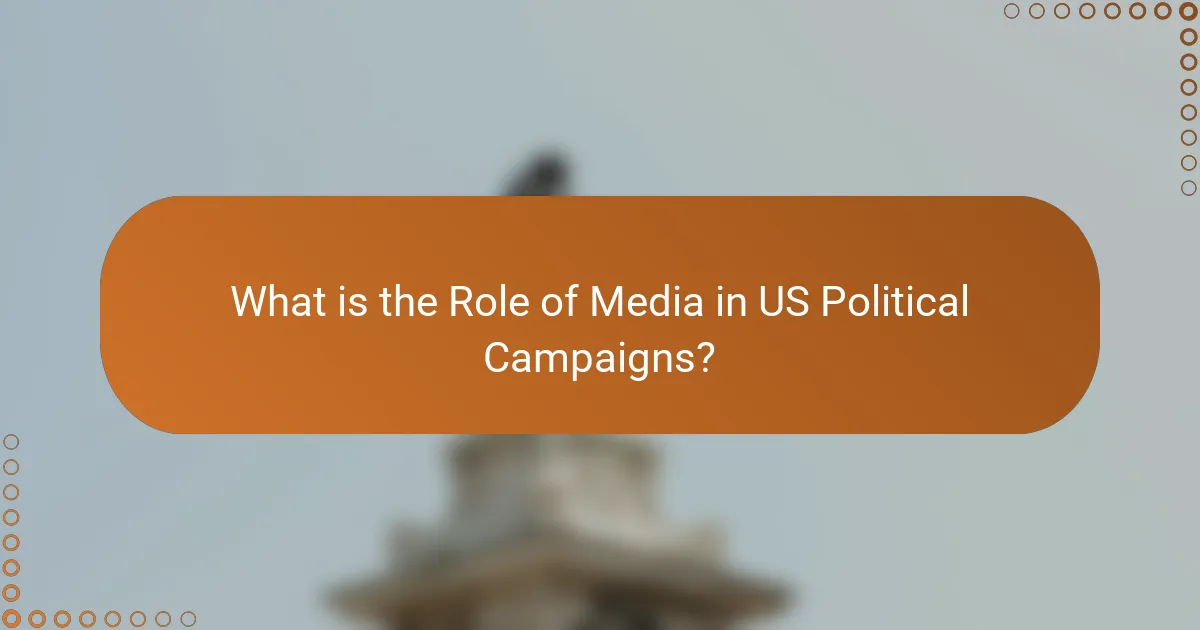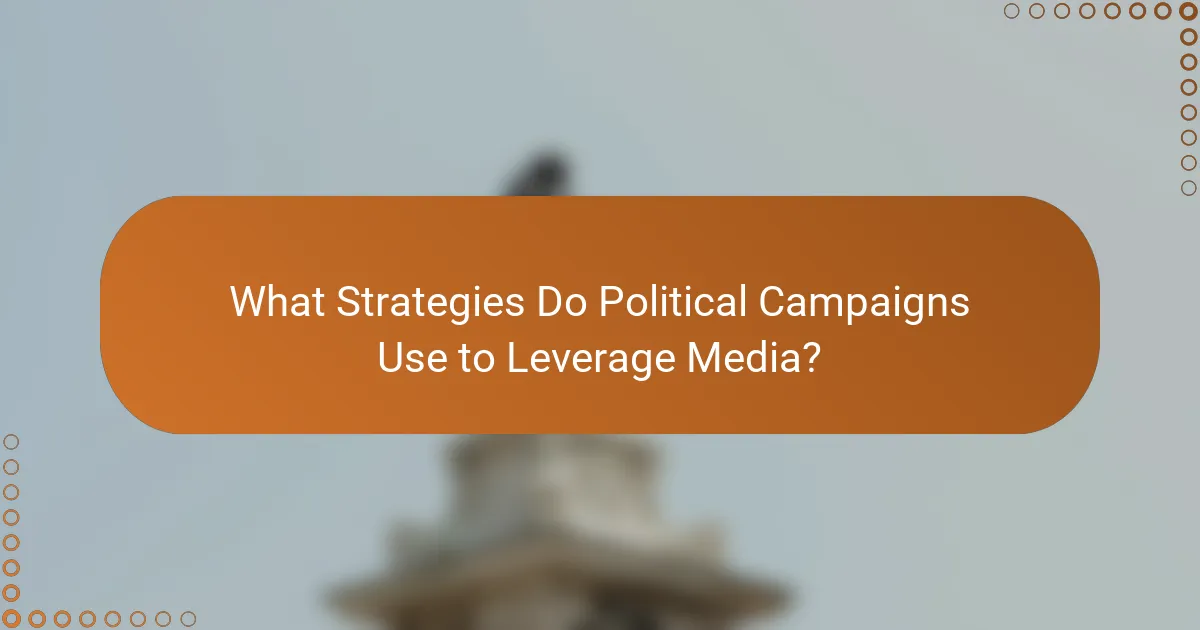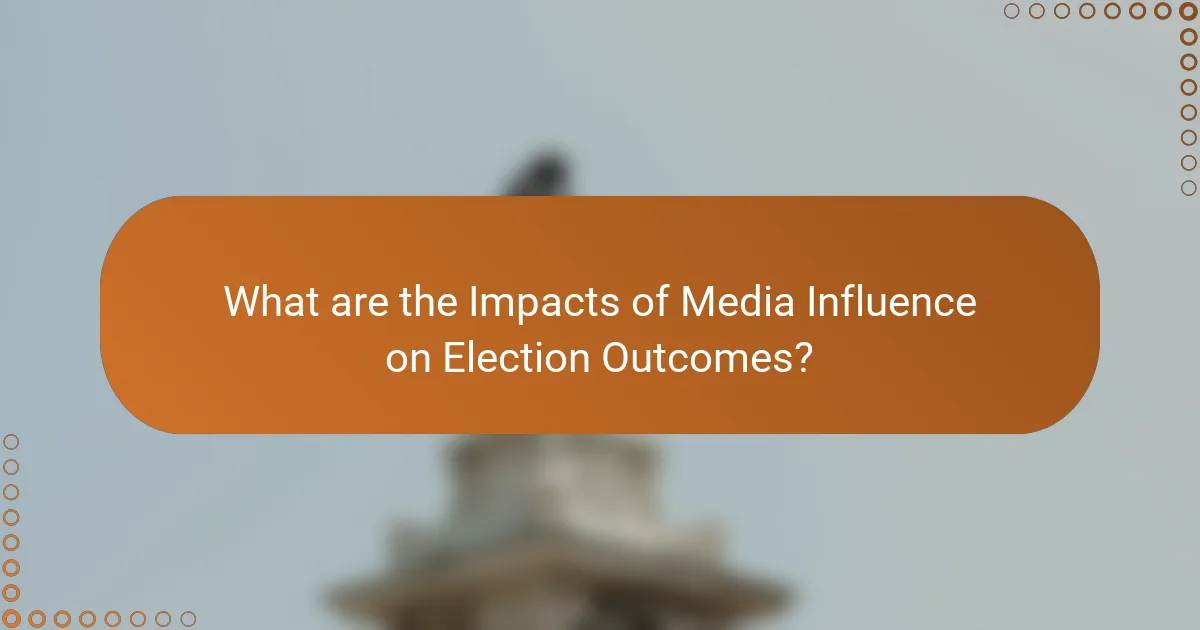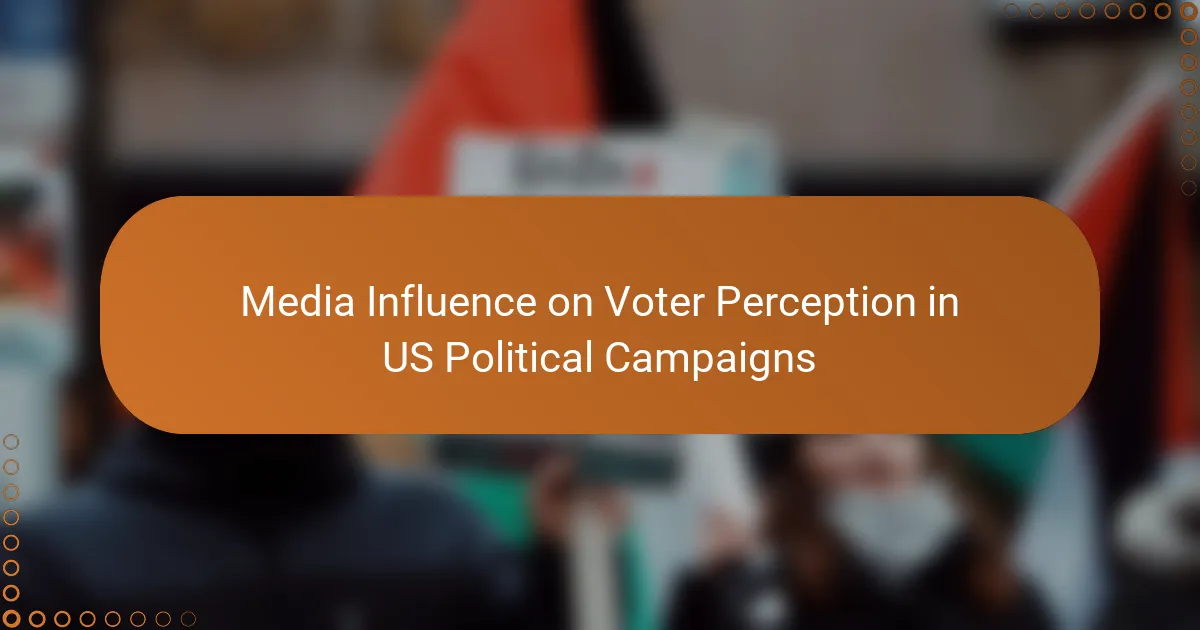The article examines the influence of media on voter perception during US political campaigns. It highlights the role of both traditional media, such as television, and social media, particularly in engaging younger voters. The article discusses how campaigns utilize various media strategies, including targeted advertisements and press releases, to shape public opinion and enhance voter engagement. It also addresses the significant impact of media coverage on election outcomes, noting how it can sway public perception and reinforce existing beliefs through echo chambers. Overall, the article underscores the critical function of media as an intermediary in the electoral process.

What is the Role of Media in US Political Campaigns?
The role of media in US political campaigns is to inform, influence, and engage voters. Media serves as a platform for candidates to communicate their messages. It shapes public perception through coverage of events, debates, and advertisements. Social media has become increasingly significant in reaching younger voters. According to the Pew Research Center, 53% of voters aged 18-29 reported getting news from social media in 2020. Traditional media, like television, still plays a crucial role in shaping opinions. The 2020 election saw record spending on political ads, reaching approximately $14 billion. This demonstrates the media’s impact on campaign strategies and voter engagement.
How does media influence voter perception during elections?
Media influences voter perception during elections by shaping information access and framing narratives. It provides platforms for candidates to communicate their messages. This exposure can affect public opinion and voting behavior. Studies show that media coverage can sway undecided voters. For example, a 2018 Pew Research Center study found that 68% of Americans get news about political issues from social media. This reliance on media impacts the way voters interpret candidates’ positions. Additionally, the framing of issues can create biases, leading to skewed perceptions. Research indicates that negative coverage often results in lower approval ratings for candidates. Thus, the media plays a crucial role in informing and influencing voter perceptions.
What are the main types of media that impact voter perception?
The main types of media that impact voter perception are traditional media, digital media, and social media. Traditional media includes television, radio, and newspapers. These platforms have historically shaped public opinion through news coverage and political advertising. Digital media encompasses online news websites and streaming services, which provide access to political content. Research shows that digital media consumption has increased among voters, influencing their perceptions. Social media platforms, such as Facebook and Twitter, allow for real-time interaction and dissemination of information. Studies indicate that social media can amplify political messages and mobilize voter engagement. Each type of media plays a crucial role in shaping how voters perceive candidates and issues.
How do different media formats affect voter engagement?
Different media formats significantly affect voter engagement. Research shows that visual media, such as videos and infographics, increase engagement levels compared to text-based formats. For instance, the Pew Research Center found that social media platforms boost voter interaction by 20% compared to traditional media. Additionally, interactive formats, like polls and quizzes, are proven to enhance participation rates. A study by the Knight Foundation indicated that voters exposed to interactive content were 35% more likely to engage in discussions about elections. Therefore, the choice of media format plays a crucial role in shaping voter engagement.
Why is understanding media influence crucial for voters?
Understanding media influence is crucial for voters because it shapes their perceptions and decisions. Media outlets provide information that can frame political issues and candidates. This framing can significantly impact voter opinions and behaviors. Research shows that exposure to specific narratives can sway public sentiment. For instance, studies indicate that voters often rely on media for cues about candidate viability. A study by the Pew Research Center found that 62% of adults get news from social media. This highlights the importance of understanding how media content can distort or clarify political messages. Voters who comprehend media influence are better equipped to critically evaluate information. This critical evaluation can lead to informed voting decisions.
What psychological factors make voters susceptible to media influence?
Cognitive biases and emotional responses make voters susceptible to media influence. Cognitive biases, such as confirmation bias, lead voters to favor information that aligns with their pre-existing beliefs. This can distort their perception of facts presented by the media. Emotional responses, including fear and enthusiasm, can also significantly impact voter behavior. For instance, media narratives that evoke strong emotions can sway opinions and increase engagement. Studies show that emotionally charged content is more likely to be shared and remembered. Additionally, social identity theory suggests that voters may align with media portrayals that resonate with their group identity. This further reinforces their susceptibility to media influence.
How does media framing shape political narratives?
Media framing shapes political narratives by influencing how issues are perceived and understood by the public. It involves the presentation of information in a specific context that highlights certain aspects while downplaying others. For example, framing a political issue as a crisis can evoke urgency and fear, affecting public opinion and voter behavior. Studies show that different frames can lead to varying interpretations of the same event. Research by Iyengar and Kinder (1987) demonstrated that news frames significantly affect audience attitudes and beliefs. This framing process ultimately shapes the political discourse and can sway electoral outcomes.

What Strategies Do Political Campaigns Use to Leverage Media?
Political campaigns use various strategies to leverage media effectively. They utilize social media platforms to engage with voters directly. Campaigns create targeted advertisements to reach specific demographics. They also employ press releases to generate media coverage and public interest. Additionally, candidates participate in interviews and debates to showcase their positions. Campaigns analyze media trends to adjust their messaging accordingly. They often collaborate with influencers to expand their reach. Data analytics help campaigns measure the effectiveness of their media strategies. These approaches enhance visibility and influence voter perception.
How do campaigns tailor their messages for different media platforms?
Campaigns tailor their messages for different media platforms by adapting content to fit the unique characteristics of each platform. For instance, social media platforms like Twitter require concise messaging due to character limits. In contrast, platforms like Facebook allow for more detailed posts and visual content.
Television ads often utilize emotional storytelling to engage viewers quickly. Print media can offer in-depth analysis and longer articles to inform voters thoroughly. Campaigns also consider audience demographics and preferences on each platform.
For example, younger audiences may be more active on Instagram, prompting campaigns to use vibrant visuals and trending hashtags. Research has shown that tailored messaging can increase engagement and effectiveness, as seen in the 2020 U.S. election where targeted ads on social media significantly influenced voter turnout.
What are the best practices for creating effective media content?
Effective media content creation involves clarity, engagement, and relevance. Content must be clear to ensure the audience understands the message. Engaging visuals and narratives capture attention and enhance retention. Tailoring content to the target audience increases its impact. Utilizing data and facts strengthens credibility. Consistency in messaging across platforms fosters trust. Regular updates keep the content fresh and relevant. According to a study by the Pew Research Center, 64% of voters engage with political content that resonates with their values.
How do campaigns utilize social media to engage voters?
Campaigns utilize social media to engage voters by creating targeted content and facilitating direct communication. They tailor messages to specific demographics based on user data. This approach enhances relevance and encourages interaction. Campaigns also use social media platforms for live events, allowing real-time voter participation. Additionally, they leverage paid advertising to increase visibility and reach. Engaging visuals and shareable content foster organic sharing among users. Data from the Pew Research Center indicates that 69% of adults in the U.S. use social media, making it a vital tool for outreach. Social media enables campaigns to respond quickly to voter concerns and feedback, fostering a sense of community and involvement.
What role does advertising play in shaping voter perception?
Advertising significantly shapes voter perception by influencing opinions and attitudes toward candidates. Political advertisements convey messages that can highlight a candidate’s strengths or weaknesses. They often utilize emotional appeals to connect with voters on a personal level. Research shows that targeted advertising can effectively reach specific demographics, tailoring messages to resonate with their values. For instance, a study by the Pew Research Center found that 62% of voters reported being influenced by campaign ads. Additionally, negative advertising can create doubt about opponents, impacting public perception. This strategic use of advertising plays a crucial role in determining electoral outcomes.
How do negative and positive ads affect voter opinions?
Negative and positive ads significantly influence voter opinions. Positive ads generally enhance a candidate’s image and increase voter support. They highlight a candidate’s strengths and achievements, fostering a favorable perception. Conversely, negative ads tend to generate skepticism and reduce trust in opponents. They focus on portraying the weaknesses or failures of rival candidates. Research indicates that negative ads can be more memorable and impactful, as they evoke stronger emotional responses. For instance, a study by the American Political Science Review found that negative ads can shift voter preferences by as much as 10%. Overall, both types of ads play crucial roles in shaping voter perceptions during campaigns.
What are the ethical considerations of political advertising?
Ethical considerations of political advertising include truthfulness, transparency, and fairness. Political ads must not mislead voters with false information. They should disclose funding sources to ensure transparency. Fairness requires equal representation of opposing viewpoints. Additionally, ads should avoid exploiting vulnerable populations. The Federal Election Commission regulates these aspects to promote ethical standards. Studies show that misleading ads can significantly impact voter perception and trust. Ethical advertising fosters informed decision-making among voters.

What are the Impacts of Media Influence on Election Outcomes?
Media influence significantly impacts election outcomes by shaping voter perceptions and behaviors. Various studies indicate that media coverage can sway public opinion regarding candidates and issues. For example, a 2016 Pew Research Center study found that 62% of Americans get their news from social media, which can create echo chambers. These echo chambers reinforce existing beliefs, affecting voter decisions. Additionally, negative media portrayals of candidates can lead to decreased support. Research by the American Political Science Review shows that media framing can alter how voters interpret candidate actions and policies. Overall, the media serves as a critical intermediary in the electoral process, influencing how voters perceive their choices.
How does media coverage affect voter turnout?
Media coverage significantly impacts voter turnout by shaping public awareness and engagement. Increased media visibility often correlates with higher voter participation rates. Research shows that comprehensive coverage of elections informs voters about candidates and issues. For instance, a study by the Pew Research Center found that 38% of voters reported that news coverage influenced their decision to vote. Furthermore, media narratives can create urgency, motivating individuals to participate in elections. Conversely, lack of coverage can lead to voter apathy and decreased turnout. Thus, media coverage plays a crucial role in mobilizing voters during elections.
What evidence exists linking media influence to election results?
Media influence significantly impacts election results. Studies show that media coverage shapes public perception of candidates. For instance, the 2016 U.S. presidential election demonstrated that candidates with more favorable media coverage tended to receive higher voter support. Research by Pew Research Center indicated that 62% of voters reported that news coverage influenced their voting decisions. Additionally, a study published in the Journal of Politics found that negative media portrayals can lead to decreased voter support for candidates. Furthermore, social media’s role in spreading information and misinformation has been linked to shifts in voter behavior, as seen in the 2020 election. These findings underscore the critical relationship between media influence and electoral outcomes.
How do media narratives change during different election cycles?
Media narratives shift significantly during different election cycles. These changes are influenced by factors such as candidate profiles, key issues, and public sentiment. For example, during presidential elections, narratives often focus on candidates’ personalities and their ability to connect with voters. In contrast, midterm elections typically emphasize party control and legislative achievements.
Research by the Pew Research Center indicates that media coverage increases in intensity during election years, affecting voter perceptions. In 2020, for instance, coverage of the COVID-19 pandemic shaped narratives around candidate responses and leadership styles. This demonstrates how timely issues can pivot media focus and influence public opinion.
Furthermore, the rise of social media has altered traditional media narratives. Platforms like Twitter and Facebook allow for real-time updates and engagement, which can rapidly shift narratives based on trending topics and public reactions. This dynamic nature of media narratives highlights their adaptability during different election cycles.
What are the long-term effects of media influence on political engagement?
Media influence on political engagement can lead to increased voter participation and polarization. Over time, consistent media exposure shapes individuals’ political beliefs and behaviors. Research indicates that individuals who consume political media are more likely to vote. A study by the Pew Research Center shows that media consumption correlates with a higher likelihood of civic engagement. Additionally, media can create echo chambers, reinforcing existing beliefs and contributing to political polarization. This polarization can diminish bipartisan dialogue and increase societal division. Thus, the long-term effects of media influence significantly impact political engagement and the overall political landscape.
How does media influence voter trust in political institutions?
Media significantly influences voter trust in political institutions. It shapes perceptions through framing, agenda-setting, and the portrayal of political actors. Studies show that consistent media coverage can enhance or diminish trust levels. For instance, negative reporting on government actions correlates with decreased public trust. Conversely, positive media narratives about political initiatives can bolster confidence in institutions. Research indicates that voters are more likely to trust institutions that are portrayed positively in credible media outlets. The credibility of the media source also affects trust; voters tend to trust institutions more when information comes from reputable news organizations.
What strategies can voters use to critically assess media messages?
Voters can use several strategies to critically assess media messages. First, they should verify the source of the information. Reliable sources typically have a history of factual reporting. Second, voters should cross-check information across multiple outlets. This helps to identify any biases or inconsistencies. Third, analyzing the language used in media messages is essential. Emotional language often indicates an attempt to manipulate perceptions. Fourth, voters should consider the context of the information. Understanding the background can clarify the intent behind a message. Fifth, recognizing the difference between opinion pieces and factual reporting is crucial. Opinion pieces reflect personal views rather than objective facts. Lastly, utilizing fact-checking websites can provide clarity on disputed claims. These strategies empower voters to make informed decisions based on critical assessment of media messages.
How can voters navigate media influence effectively?
Voters can navigate media influence effectively by critically evaluating sources and information. They should verify facts through reputable outlets and cross-check multiple sources. Understanding media bias is crucial; knowing the perspective of a source helps in assessing the information’s reliability. Engaging in discussions with diverse viewpoints can broaden understanding and reduce echo chamber effects. Utilizing fact-checking websites can clarify misinformation. Research indicates that informed voters are less susceptible to media manipulation, enhancing decision-making. According to a study by the Pew Research Center, 64% of Americans believe that misinformation is a major problem, highlighting the importance of vigilance in media consumption.
Media is the primary entity discussed in this article, focusing on its influence on voter perception in US political campaigns. The article explores how various media types, including traditional media, digital media, and social media, shape public opinion and engagement during elections. It highlights the strategies political campaigns employ to leverage media effectively, the psychological factors that make voters susceptible to media influence, and the ethical considerations surrounding political advertising. Additionally, the article examines the long-term effects of media on voter trust and political engagement, providing insights into how voters can critically assess media messages to navigate influence effectively.
